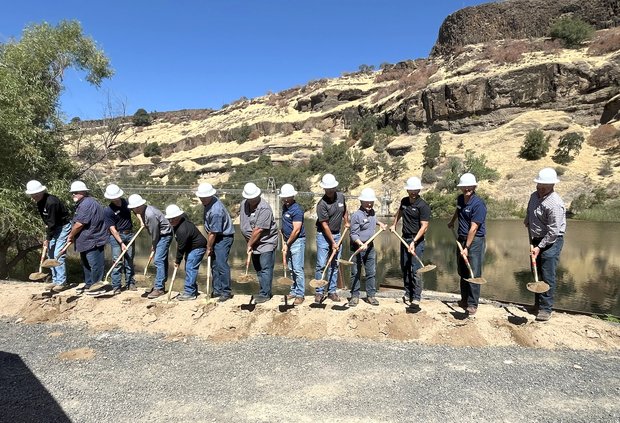Del Norte razor clam fishery opens under health advisory – Oakdale Leader

Report on the Status of the Recreational Razor Clam Fishery in Northern California
Executive Summary
This report details the conditional re-opening of the recreational razor clam fishery in Del Norte County, California. The decision, effective as of August 2025, is based on recent scientific data indicating a reduction in domoic acid to safe levels. However, a separate, broader health advisory concerning Paralytic Shellfish Poisoning (PSP) remains active. The management of this fishery reflects a commitment to several United Nations Sustainable Development Goals (SDGs), primarily SDG 14 (Life Below Water), SDG 3 (Good Health and Well-being), and SDG 12 (Responsible Consumption and Production).
Fishery Status and Public Health Advisories
Del Norte County Fishery Re-opening
The Director of the California Department of Fish and Wildlife (CDFW) has re-opened the recreational razor clam fishery in Del Norte County. This action follows a closure enacted in November 2023 due to hazardous domoic acid levels. Recent testing in June and July 2025 confirmed that domoic acid concentrations in razor clams from Crescent Beach are now below the federal action level of 20 parts per million (ppm). This data-driven management decision directly supports SDG 14 (Life Below Water) by ensuring that the utilization of marine resources is sustainable and scientifically monitored.
Persistent Health Risks and Consumer Warnings
Despite the re-opening for razor clams, the California Department of Public Health (CDPH) maintains a bivalve shellfish health advisory for Del Norte County, originally issued on July 3, 2025. This advisory warns consumers against the consumption of any sport-harvested bivalve shellfish, including mussels, scallops, and clams, due to dangerous levels of Paralytic Shellfish Poisoning (PSP) toxins. This critical public safety measure aligns with SDG 3 (Good Health and Well-being) by actively working to prevent foodborne illness and protect human health.
Humboldt County Fishery Status
The razor clam fishery in neighboring Humboldt County remains closed. This closure is due to persistently elevated levels of domoic acid, demonstrating a precautionary approach that prioritizes both SDG 3 and SDG 14 by preventing the harvest of contaminated marine life.
Management Framework and Sustainable Development
Toxin Monitoring and Inter-Agency Collaboration
The re-opening in Del Norte County is the result of continuous and rigorous monitoring by state health agencies. This scientific oversight is fundamental to the principles of SDG 14 (Life Below Water), ensuring that marine ecosystems are protected from harmful activities. The coordinated efforts between the CDFW and CDPH exemplify SDG 17 (Partnerships for the Goals), showcasing effective collaboration between government bodies to achieve shared public health and environmental sustainability objectives. Testing for PSP and other marine biotoxins will continue.
Regulations for Responsible and Sustainable Harvesting
To ensure the long-term health of the clam population and promote ethical harvesting practices, the CDFW enforces specific regulations. These rules are a practical application of SDG 12 (Responsible Consumption and Production), guiding consumers toward sustainable interaction with natural resources.
- Daily Bag Limit: The limit is 20 razor clams per person.
- Retention Rule: The first 20 clams dug must be retained, regardless of size or condition.
- Harvesting Area: During odd-numbered years, the fishery is open north of Battery Point in Crescent City, Del Norte County.
- Containment: Each individual must keep their harvested clams in a separate container.
Public Information and Resources
To ensure public awareness and safety, several resources are available for the latest information. Access to timely and accurate data empowers the public to make informed decisions, supporting the overall goals of public health and sustainable resource management.
- CDFW Fishery Closures & Health Advisories: https://www.wildlife.ca.gov/Fishing/Ocean/Health-Advisories
- CDFW Domoic Acid Information Line: 831-649-2883
- CDPH Biotoxin Information Line: 800-553-4133 or 510-412-4643
- CDPH Recreational Bivalve Shellfish Advisory Map: An interactive map with recent testing data.
- U.S. Tsunami Warning Centers: For information on coastal access restrictions due to tsunami advisories.
Analysis of Sustainable Development Goals (SDGs) in the Article
1. Which SDGs are addressed or connected to the issues highlighted in the article?
The article primarily addresses issues related to two Sustainable Development Goals, with secondary connections to others. The analysis is as follows:
- SDG 14: Life Below Water: This is the most relevant SDG. The article is centered on the management of a marine resource (razor clams). It discusses the regulation of a fishery, the health of marine ecosystems (indicated by toxin levels), and the implementation of science-based management plans to ensure the sustainable use of these resources. The closure and reopening of the fishery based on scientific monitoring of domoic acid levels directly relates to conserving and sustainably using the oceans and marine resources.
- SDG 3: Good Health and Well-being: This goal is also central to the article. The entire reason for the fishery closure and the ongoing health advisories is to protect human health. The article explicitly warns consumers about the dangers of consuming shellfish contaminated with domoic acid and paralytic shellfish poisoning (PSP) toxins, which can cause severe illness. The actions of the California Department of Public Health (CDPH) and the California Department of Fish and Wildlife (CDFW) are aimed at preventing foodborne illness from marine biotoxins.
- SDG 2: Zero Hunger: While the fishery is described as “recreational,” shellfish are a food source. The article’s focus on ensuring the safety of this food source connects to the broader goal of ensuring access to safe and nutritious food. The health advisories directly impact the safety and availability of this particular food item.
2. What specific targets under those SDGs can be identified based on the article’s content?
Based on the article’s content, several specific SDG targets can be identified:
-
Target 14.4: “By 2020, effectively regulate harvesting and end overfishing, illegal, unreported and unregulated fishing and destructive fishing practices and implement science-based management plans, in order to restore fish stocks in the shortest time feasible…”
- Explanation: The article demonstrates the implementation of a science-based management plan. The CDFW uses test results from state health agencies to regulate the razor clam fishery. The closure in November 2023 and the reopening in Del Norte County are direct results of this scientific monitoring. Furthermore, the article mentions specific regulations to control harvesting, such as the “daily bag limit for razor clams is 20” and the rule that “the first 20 clams dug must be retained regardless of size or condition.”
-
Target 3.9: “By 2030, substantially reduce the number of deaths and illnesses from hazardous chemicals and air, water and soil pollution and contamination.”
- Explanation: The core public safety message of the article aligns with this target. The monitoring of domoic acid and PSP toxins is a direct measure to prevent illnesses from water and food contamination. The article states that health agencies determined that “domoic acid no longer poses a significant threat” in one area, while warning that “dangerous levels of paralytic shellfish poisoning (PSP) toxins remains in effect” for other bivalves, clearly showing an effort to reduce illness from these hazardous natural toxins.
-
Target 14.a: “Increase scientific knowledge, develop research capacity and transfer marine technology… in order to improve ocean health and to enhance the contribution of marine biodiversity to the development of developing countries…”
- Explanation: The actions described in the article are entirely dependent on scientific knowledge and research capacity. State health agencies are conducting ongoing monitoring: “State health agencies have continued to monitor domoic acid levels in razor clams since the closure…” The use of specific data (e.g., parts per million) and tools like the “Recreational Bivalve Shellfish Health Advisory Map” demonstrates the application of scientific research to manage ocean health and human interaction with it.
3. Are there any indicators mentioned or implied in the article that can be used to measure progress towards the identified targets?
Yes, the article mentions several specific and measurable indicators that are used to track progress towards the identified targets.
-
Indicator for Target 3.9 and 14.4: Concentration of domoic acid.
- Explanation: The article provides a precise, quantitative indicator used for regulation. It states that the fishery was closed due to levels “exceeding the federal action level (≥20 parts per million (ppm))” and was reopened after clams collected had “domoic acid concentrations lower than the federal action level.” This is a direct, science-based indicator for food safety and ecosystem health.
-
Indicator for Target 3.9: Presence of Paralytic Shellfish Poisoning (PSP) toxins.
- Explanation: While a specific numerical value is not given, the article clearly indicates that the presence of PSP toxins at “dangerous levels” is a key indicator used to issue and maintain health advisories. The ongoing “bivalve shellfish health advisory” is based on testing for these specific toxins.
-
Indicator for Target 14.4: Fishery status (open/closed) and harvesting regulations.
- Explanation: The status of the fishery itself is an indicator of management action. The article reports that the fishery is “re-opened” in Del Norte County but “remains closed in Humboldt County.” Additionally, the specific regulations mentioned, such as the “daily bag limit for razor clams is 20,” serve as indicators of how harvesting is being managed.
-
Indicator for Target 14.a: Availability of public information and monitoring data.
- Explanation: The article points to several resources that serve as indicators of increased scientific communication and data sharing. These include the “Recreational Bivalve Shellfish Health Advisory Map,” the “Domoic Acid Fishery Closure Information Line,” and the “Biotoxin information Line,” all of which measure the capacity to provide the public with timely, science-based information.
4. Table of SDGs, Targets, and Indicators
| SDGs | Targets | Indicators |
|---|---|---|
| SDG 14: Life Below Water | Target 14.4: Effectively regulate harvesting and implement science-based management plans. |
|
| SDG 3: Good Health and Well-being | Target 3.9: Substantially reduce illnesses from hazardous chemicals and water/food contamination. |
|
| SDG 14: Life Below Water | Target 14.a: Increase scientific knowledge and research capacity to improve ocean health. |
|
Source: oakdaleleader.com

What is Your Reaction?
 Like
0
Like
0
 Dislike
0
Dislike
0
 Love
0
Love
0
 Funny
0
Funny
0
 Angry
0
Angry
0
 Sad
0
Sad
0
 Wow
0
Wow
0











































































